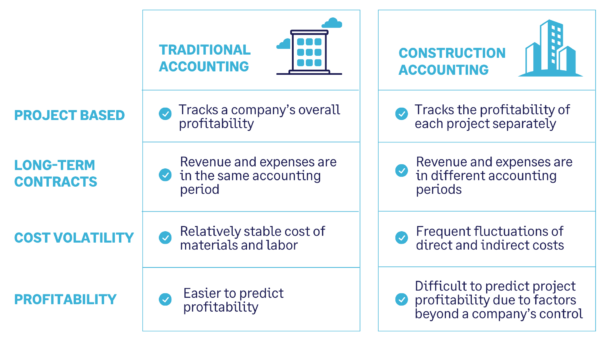Key Characteristics to Look for in Construction Accounting Software Tools
Key Characteristics to Look for in Construction Accounting Software Tools
Blog Article
A Comprehensive Overview to Construction Accountancy: Maximize Your Financial Monitoring
Reliable monetary management is crucial in the construction sector, where the intricacies of project-based income and expenses can significantly influence general success. By using ideal methods in financial reporting and evaluation, stakeholders can not just boost operational effectiveness but additionally alleviate potential threats.
Comprehending Construction Accounting
Comprehending construction audit is crucial for the successful administration of financial sources in the building sector. This specific branch of audit addresses the special challenges dealt with by construction firms, consisting of project-based income acknowledgment, cost monitoring, and compliance with regulative needs. Unlike conventional audit, construction audit requires an unique technique to take care of the complexities related to lasting contracts and rising and fall costs.
Secret parts of construction accountancy consist of accurate income acknowledgment, which often depends on the percentage-of-completion technique or completed-contract approach, depending on the project's nature. This makes sure that economic declarations reflect true performance and earnings with time. Job costing plays an important role, allowing firms to track expenses associated with specific projects, which aids in determining profitability and resource allocation.
An additional crucial facet is the monitoring of capital, which is commonly affected by repayment schedules and delays in receivables. Reliable capital administration guarantees that construction companies can fulfill functional requirements and invest in future tasks. Inevitably, grasping construction audit gears up companies with the devices needed to make educated financial choices, alleviate risks, and boost general operational performance in an affordable industry.

Job Costing and Budgeting
Work setting you back and budgeting are important elements of building accounting that enable companies to successfully handle project funds and make certain earnings. Task costing entails the careful tracking of all prices related to a particular project, consisting of labor, materials, tools, and expenses. This process allows building companies to identify truth cost of finishing a job, facilitating notified decision-making and enhancing economic responsibility.
Budgeting, on the various other hand, serves as a financial roadmap for jobs. It involves establishing financial limitations and allocating sources to various task components, consequently establishing a structure versus which actual prices can be measured. Reliable budgeting requires detailed analysis and projecting, considering historic data, market patterns, and potential dangers.
With each other, job setting you back and budgeting give the required devices for construction firms to check financial performance, recognize differences, and adjust methods as required - construction accounting. By executing robust work setting you back practices and adhering to well-structured budget plans, firms can improve their operational effectiveness, minimize economic risks, and eventually improve their productivity in a competitive marketplace. Thus, these methods are crucial for maintaining lasting success within the construction industry
Tracking Expenses and Income
Precisely tracking expenses and income is essential for building and construction firms to maintain monetary health and wellness and make sure task stability. Reliable monitoring permits organizations to check task efficiency, recognize price overruns, and make educated economic choices. Carrying out a methodical technique to taping all monetary deals is essential to accomplishing this goal.
Utilizing building and construction audit software program can substantially improve the tracking process. These devices assist in real-time surveillance of expenditures, including labor, materials, and her response subcontractor prices, while additionally catching income generated from task milestones and customer settlements. By categorizing expenses and earnings streams, companies can acquire understandings right into success and cash circulation.

Financial Reporting and Evaluation
Monetary reporting and evaluation play a pivotal duty in the building sector, supplying stakeholders with important understandings into a company's financial efficiency and operational performance. Accurate monetary reports, including equilibrium sheets, earnings declarations, and cash circulation statements, are essential for assessing the health and wellness of a construction company. These documents assist recognize trends, examine task success, and promote informed decision-making.
In building and construction bookkeeping, economic analysis exceeds plain reporting; it involves inspecting monetary data to reveal underlying patterns and anomalies. Key performance signs (KPIs), such as gross earnings margins, job conclusion prices, and return on investment, work as standards to determine view website operational success. On a regular basis assessing these metrics allows firms to determine locations calling for renovation, optimize resource allotment, and improve task monitoring strategies.
Additionally, efficient monetary coverage promotes openness and develops depend on with stakeholders, consisting of clients, providers, and financiers - construction accounting. By preserving extensive monetary oversight, building business can alleviate dangers, make sure conformity with regulative demands, and eventually drive sustainable growth. Thus, a robust economic coverage and evaluation framework is important for navigating the complexities of the construction landscape and achieving lasting success
Ideal Practices for Success
To accomplish success next in building bookkeeping, companies must take on a collection of finest practices that streamline procedures and improve monetary management. Initially, applying a durable project management software program tailored for construction can promote real-time monitoring of job costs and spending plans, enabling more exact forecasting and source allowance.
Second, taking on a consistent technique to job costing is critical. This includes diligently tracking all costs connected with each task, including labor, materials, and expenses. Regularly assessing work costs versus preliminary estimates assists recognize variances early, enabling prompt rehabilitative actions.
Third, preserving strenuous documents practices ensures compliance with policies and streamlines audits. This consists of maintaining in-depth documents of agreements, adjustment orders, billings, and receipts.
Additionally, purchasing personnel training is necessary. Making certain that staff members are fluent in accounting concepts, software program use, and sector requirements can dramatically boost effectiveness and precision in monetary reporting.
Conclusion

Report this page